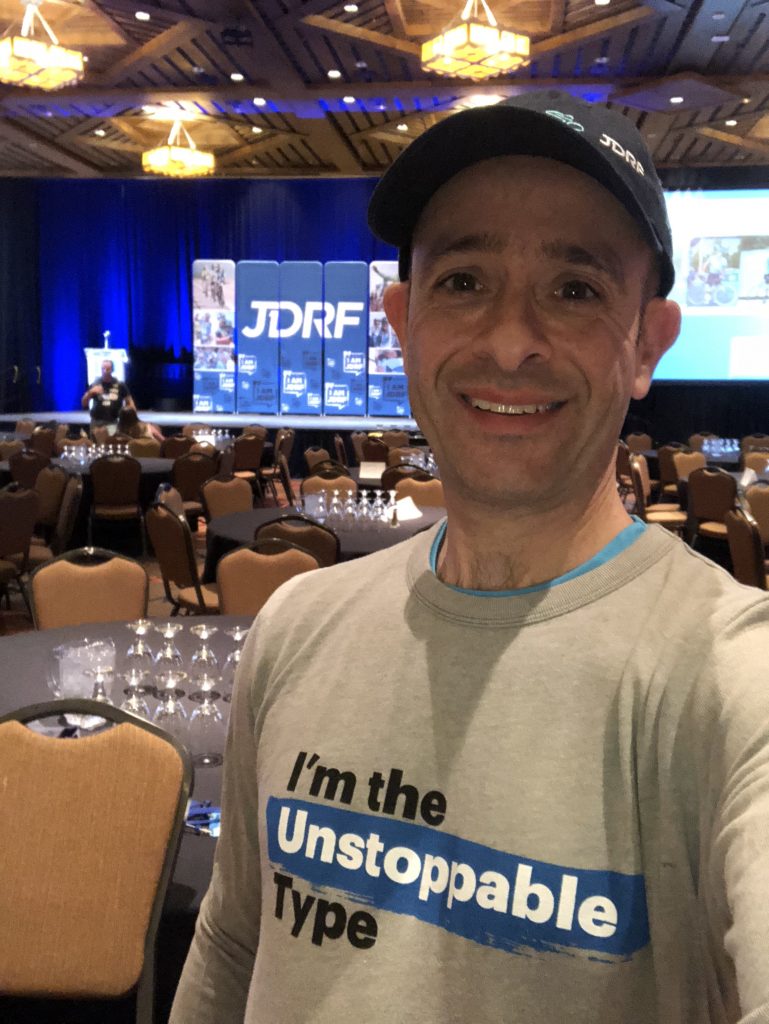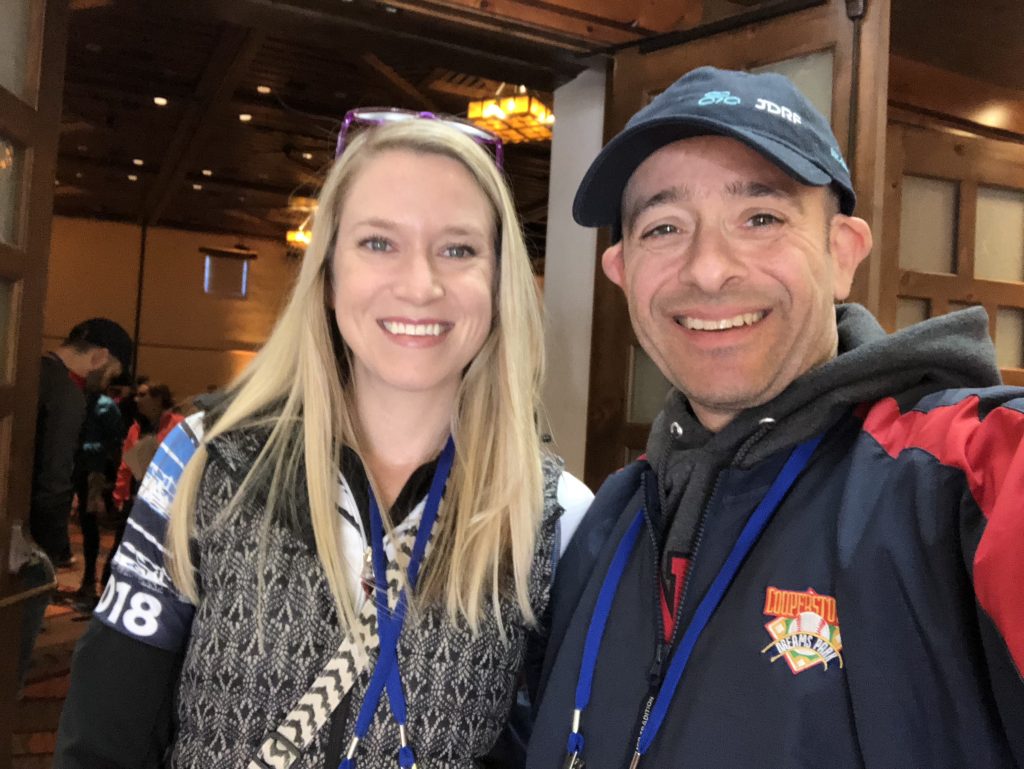The minivan passed me as I was cycling up a never-ending hill, arms waving from open windows. The van pulled over a few hundred feet ahead, arms still waving from the windows. They must want to high-five me, I thought, so I raised my arm as I passed them and slapped their hands.
It turns out they didn’t want to high-five me for cycling up a 3-mile hill. They wanted to stop me because I and my teammate Ralph were off course. We had missed a turn 3 miles back.
You mean I climbed this hill for nothing?!
We turned our bikes around, coasted down the hill, and got back on course. We were already 70+ miles and several hours into the ride. All we could do is laugh at ourselves and summon extra energy from our tired bodies to complete the ride, which turned into a 104-mile journey when we finally crossed the finish line.
Below are some photos from the JDRF Ride to Cure in Santa Fe, including some scenic ones of the course taken by teammate Kelly McCauslin from BluJay Solutions (who set a personal mileage record that day!) And here is a short video from the pre-ride dinner highlighting why I got involved with JDRF:
It was cold when we started the ride (36F) and we faced headwinds all day, but it was a beautiful course and we collectively raised over $2,000,000 for JDRF!
Our Logistics Leaders for Type 1 Diabetes Cure Team raised $59,231 this season — a new record! — bringing our three year total to over $150,000! (It’s not too late to donate.)
I didn’t climb that hill for nothing!
I want to thank all of our team members once again for their time and commitment to train and fundraise over the past few months. I also want to thank our sponsors and supporters for their generous donations, including BluJay Solutions, C.H. Robinson, Descartes Systems Group, MercuryGate, Transplace, Opus9, Paragon, and TranzAct Technologies. Simply put, without your support, this audacious dream I had three years ago to form a logistics cycling team to support JDRF wouldn’t have come true.
You quickly forget how hard it is to ride 100 miles (especially when it’s cold and windy and you’re 7,200 feet above sea level), which is why I’m excited do it all again next year! If you’re interested in riding with us next year or sponsoring our team, please contact me for details.
Okay, turning the corner, here’s the supply chain and logistics news that caught my attention this week:
- Amazon offers free shipping on all orders for the holidays (CNN)
- Data Science In Walmart Supply Chain Technology (Medium)
- XPO Logistics Announces Four New Technology Initiatives for Less-Than-Truckload Optimization
- Turvo, the World’s First Real-Time Collaborative Logistics Platform, Raises $60M Series B Funding
- project44 Announces Multimodal Integration with Oracle Transportation Management
- Elemica Introduces New Benefits to its Digital Supply Network and Supply Chain Solutions for Improving Customer Experience and Digitization
- enVista Joins Blockchain in Transport Alliance
- Top Ocean Carriers and Terminal Operators Initiate Blockchain Consortium
- Hub Group To Acquire CaseStack, Inc.
- More Factories Crop Up Closer to Customers (WSJ – sub. req’d)
- BNSF Railway, Trucker J.B. Hunt Locked in Freight Revenue Dispute (WSJ – sub. req’d)
- Shipping Rates to Increase for FedEx Express, FedEx Ground and FedEx Freight Services
Free Shipping as a Competitive Weapon (and Loss Leader)
A couple of weeks ago, Target announced that it would offer free 2-day shipping this holiday season. Amazon responded this week by announcing free shipping for all orders too, even for non-Prime members. As reported by CNBC:
For the first time, Amazon is offering free shipping on all US holiday orders in an effort to add new Prime members and juice the season’s sales numbers.
Last year, Amazon shoppers without Prime memberships had to spend at least $25 to earn free shipping, but Amazon is waiving the purchase minimum starting Monday to give “customers even more convenient and faster delivery options,” the company announced.
Prime members in the United States do get a holiday perk, however. Amazon is making more than three million items eligible for same-day delivery for the holidays.
As consumers, we’ve come to expect free and fast shipping. For retailers, however, “free shipping” is like starting a baseball game already down by 3 runs. They have to find a way to make up that deficit somehow in order to ultimately win. Amazon makes it up with profits from its Amazon Web Services business; other retailers have to find cost savings and efficiencies elsewhere in their supply chain and logistics processes. Most end up losing the game.
Supply Chain Visibility Solved (Stop Me If You Think You’ve Heard This One Before)
Turvo announced this week that it has closed $60 million in Series B funding led by Mubadala Ventures, and also added new investors G2VP and Next47, the Siemens-backed global venture firm. Here are some additional details from the press release:
These funds bring the total investment in the company to nearly $100 million, solidifying Turvo as the new standard in end-to-end visibility and collaboration for the logistics and supply chain industry.
Turvo is revolutionizing logistics with a ground-breaking IoT software platform that creates the “Internet of Shipping”, connecting people, businesses, applications, and devices in one AI-driven solution. Turvo empowers everyone across the supply chain ecosystem to seamlessly share, communicate, and collaborate in real-time to make smarter, faster, more informed decisions.
I haven’t been briefed by Turvo yet, so I can’t comment on its technology platform. But I’m sure that being a relatively new player on the market, the company moves the needle forward in terms of technology sophistication and capabilities. If you read Turvo’s press release, however, it’s the same as countless others that have been issued over the years promising to provide end-to-end supply chain visibility (see Elementum’s $44 million funding announcement from February 2014). Yet, as Turvo comments in the press release, “companies that need to move things from A to B still use archaic technology, operate in silos, and perform countless redundant and manual tasks.”
Why is that still the case despite the fact that all sorts of technology solutions have existed for years?
I’ll repeat what I said back in 2014:
You can make supply chain apps simple to use, simple to deploy, and simple to procure — but the rest of supply chain management is anything but simple; it’s complex and messy. I’ve said it before, and I’ll say it again, software is not enough in supply chain management. You also need connectivity to trading partners and data quality management processes and systems. Otherwise, it’s still garbage in, garbage out. I encourage you to watch Why Supply Chain Visibility Remains an Elusive Goal where I discuss five key challenges companies face in their efforts to obtain timely, accurate, and complete visibility to their supply chain events and transactions, and I offer three recommendations for companies to achieve this goal.
For additional commentary, see The Big (Crappy) Data Problem in Supply Chain Management.
Simply put, the biggest barrier to supply chain visibility is not technology, but change management, data quality management, and integrating the long tail of supply chains.
And with that, have a happy weekend!
Song of the Week: “Stop Me If You Think You’ve Heard This One Before” by The Smiths

























